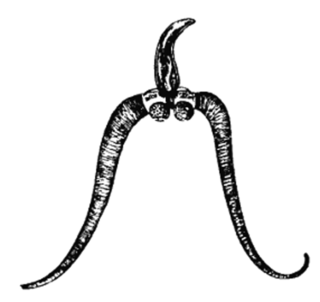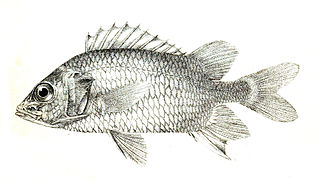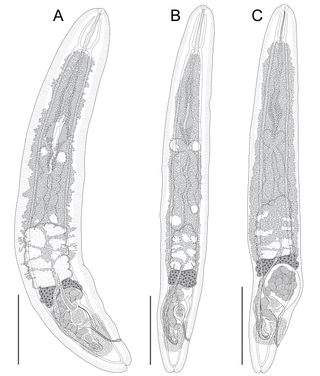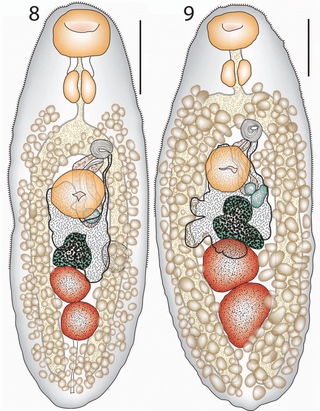
Holocentridae is a family of ray-finned fish, the only family of the order Holocentriformes. The members of the subfamily Holocentrinae are typically known as squirrelfish, while the members of Myripristinae typically are known as soldierfish. In Hawaii, they are known by the Japanese name mempachi/menpachi (メンパチ) or the Hawaiian ʻūʻū.

The map puffer, also known as the map pufferfish, scribbled pufferfish, or Kesho-fugu, is a demersal marine fish belonging to the family Tetraodontidae. The map puffer is typically found in tropical and subtropical waters from the Indian Ocean to the western Pacific Ocean. This fish contains tetrodotoxin, a potent and deadly chemical compound used to ward off predators. Despite being highly poisonous, the map puffer can be found both in the aquarium trade and certain food markets.

Sargocentron is a genus of squirrelfish found in tropical parts of the Indian, Pacific and Atlantic Oceans, with the greatest species diversity near reefs in the Indo-Pacific. Being largely or entirely nocturnal, they have relatively large eyes. Red and silvery colours dominate. The preopercle spines are venomous and can give painful wounds. Most have a maximum length of 15–25 cm (6–10 in), but S. iota barely reaches 8 cm (3 in), and S. spiniferum can reach more than 50 cm (20 in).

Spirorchiidae is a family of digenetic trematodes. Infestation by these trematodes leads to the disease spirorchiidiosis. Spirorchiids are mainly parasites of turtles. It has been synonymised with Proparorchiidae Ward, 1921, Spirorchidae Stunkard, 1921, and Spirorchiidae MacCallum, 1921.

Bucephalidae is a family of trematodes that parasitize fish. They lack suckers, having instead a muscular organ called a "rhynchus" at the front end which they use to attach to their hosts. The characteristics of the rhynchus are used to help define the genera of the family. It is one of the largest digenean families, with 25 genera containing hundreds of described species. Bucephalids are cosmopolitan, having been recorded all over the world. They are parasites of fish from freshwater, marine, and brackish water habitat types.

Holocentrinae is a subfamily of Holocentridae containing 40 recognized species and one proposed species. Its members are typically known as squirrelfish and all are nocturnal. All three genera in the subfamily are found in the Atlantic and Holocentrus is restricted to this ocean. Most species in genera Neoniphon and Sargocentron are from the Indo-Pacific region and several of these occur in the Indian Ocean west of the southern tip of India.

Opecoelidae is a family of trematodes. It is the largest digenean family with over 90 genera and nearly 900 species, almost solely found in marine and freshwater teleost fishes. It was considered by Bray et al. to belong in the superfamily Opecoeloidea Ozaki, 1925 or the Brachycladioidea Odhner, 1905.

Sargocentron caudimaculatum, the silverspot squirrelfish or whitetail squirrelfish, is a reef-associated member of the family Holocentridae. It is native to the Indian and Pacific Oceans from East Africa to Japan and northern Australia and as far east as the Marshall Islands. It lives near reefs, but can also be found in lagoons and drop-offs at depths between 2 and 40 metres. It is a nocturnal predator, feeding primarily on crabs and shrimps. It can reach sizes of up to 25.0 centimetres (9.8 in) TL. Although it is caught commercially and can be found in the aquarium trade, there are no known major threats to this species.
Transversotrema damsella is a species of parasitic flatworms found in pomacentrids, labrids and mugilids on Lizard Island.
Transversotrema borboleta is a species of parasitic flatworms found in chaetodontids and lutjanines on Heron Island and Lizard Island. It might be in fact a species complex.
Transversotrema elegans is a species of trematodes found from species of the labrid genus Choerodon on Heron Island and Lizard Island. It is characterised by its number of vitelline follicles enclosed by its cyclocoel and by the size of its testicle.

Sargocentron cornutum, the threespot squirrelfish, is a member of the family Holocentridae native to the western Pacific Ocean from Indonesia to the Great Barrier Reef. It lives in coral reefs and drop-offs between depths of 6–40 m (20–131 ft). It is a nocturnal predator, feeding on crabs and shrimps by night and hiding under ledges or in caves by day. It can reach sizes of up to 27.0 cm (10.6 in) TL and has a venomous preopercle.

Sargocentron hastatum, the red soldierfish or the red squirrelfish is a species of marine fish of the family Holocentridae. It occurs in the eastern Atlantic, from the coasts of Portugal down to Angola, including Cape Verde.

Aporocotylidae is a family of trematodes within the order Diplostomida, which contains species commonly known as fish blood flukes. It contains more than 40 genera, the largest being Cardicola. Species in this family parasite fish in both fresh and marine water.

Lepotrema acanthochromidis is a species of lepocreadiid digenean parasitic in the intestine of marine fish. It was described in 2018.

Lepotrema amansis is a species of lepocreadiid digenean parasitic in the intestine of marine fish. It was described in 2018.

Lepotrema amblyglyphidodonis is a species of lepocreadiid digenean parasitic in the intestine of marine fish. It was described in 2018.
Bathypodocotyle is a genus of trematodes in the family Opecoelidae.
Sargocentron poco, the saddle squirrelfish, is a species of squirrelfish belonging to the genus of Sargocentron. It is found in the Western Central Atlantic Ocean from the United States to the Cayman Islands, and in the Bahamas. It may also possibly be found in Cuba. It is likely to be more commonly found inhabiting shelf-edge reefs.














